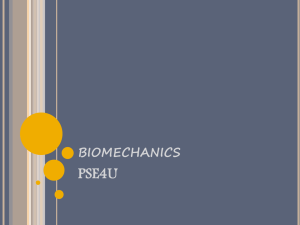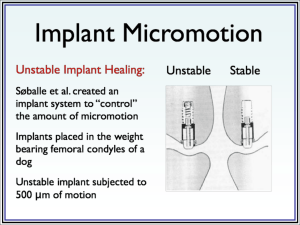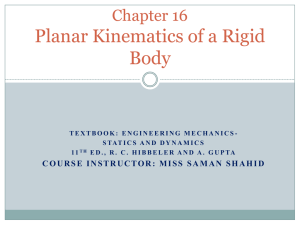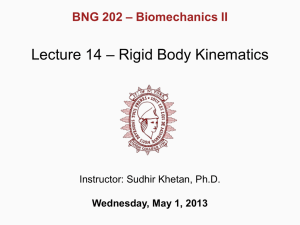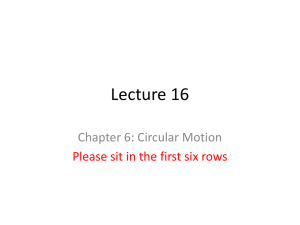Rotation
advertisement
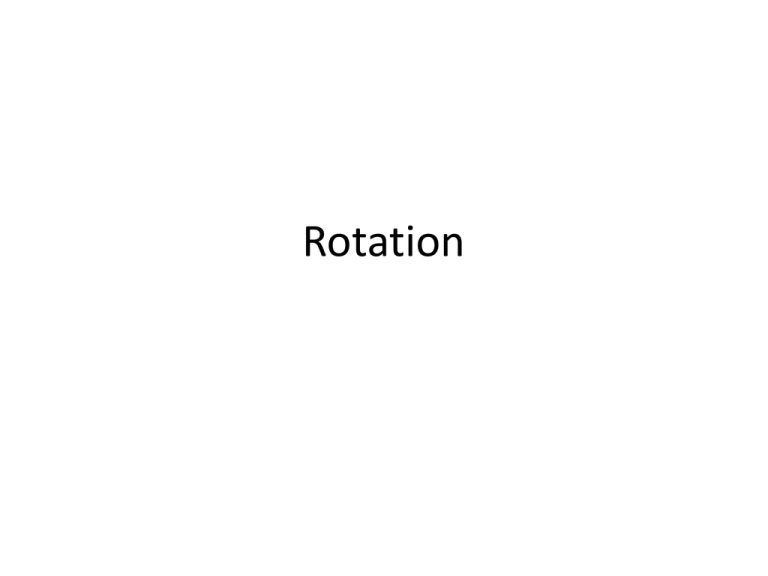
Rotation • So far we have looked at motion in a straight line or curved line- translational motion. • We will now consider and describe rotational motion – where an object turns about an axis. • So far we have looked at motion in a straight line or curved line- translational motion. • We will now consider and describe rotational motion – where an object turns about an axis. • We will start by mentioning some keywords. 1. 2. 3. 4. Angular position Angular displacement Angular velocity Angular acceleration • These terms are analogous to their linear equivalents. Angular position • The angular position is an angle measured between a reference line and a fixed direction taken as zero. Reference line Angular position • The angular position θ is: s (radians) r s: arc length Reference line Angular displacement • The angular displacement gives the change in angular position of a rotating body. 2 1 t2 Δθ θ2 t1 θ1 Counter-clockwise rotation is positive displacement. Angular velocity t2 Δθ θ2 t1 θ1 • If an object moves through the angle an angular position of θ1 to θ2 the average angular velocity is: t 2 1 t 2 t1 (average angular velocity) Angular velocity t2 Δθ θ2 t1 θ1 • Thus, lim Units: rads/s t 0 t d dt (instantaneous angular velocity) Angular acceleration • Similarly we can definite the angular acceleration as, avg lim t 0 t t Units: rads/s2 2 1 t 2 t1 d dt (average angular acceleration) (instantaneous angular acceleration) Example • The rotation of a wheel about its central axis is given by t 3 27 t 4 . Calculate the angular velocity and acceleration. Example • The rotation of a wheel about its central axis is given by t 3 27 t 4 . Calculate the angular velocity and acceleration. • Sol: d 3 t 27 2 dt d dt 6t Equations of linear and angular motion Motion Linear Angular Formula Missing variable v=v0 + at x-x0 x-x0=v0t + 1/2at2 v v2=v02 + 2a(x-x0) t x-x0=1/2(v + v0)t a x-x0=vt - 1/2at2 v0 ω=ω0 + αt θ-θ0 θ-θ0=ω0t + 1/2αt2 ω ω2=ω02 +2a(θ-θ0) t θ-θ0=1/2(ω + ω0)t α θ-θ0=ωt - 1/2αt2 ω0 Relating linear and angular • Recall that linear and angular variables can be related as follows: • Position: s r • Speed: v ds r dt v r d dt (linear velocity) Relating linear and angular • Time: T 2 r 2 v • Acceleration: a dv dt d dt r Relating linear and angular • Time: T 2 r 2 v • Acceleration: dv a d dt r dt • Thus: a t r (tangential acceleration) ar v 2 r r (radial acceleration) 2 Example • A grindstone having a constant angular acceleration of 0.35rad/s2 starts from rest with an arbitrary reference line horizontal at angular position 0 . What is the angular displacement of the reference line at t=18s? 0 • Sol: What equation do we use? • Sol: 0 0t 1 2 t 2 • Sol: 0 0t 1 2 t 2 0 0 0 0 (starts from rest) 0 0 1 2 0 . 35 18 2 0 56 . 7 rad 3200 9 rev • What is the wheel’s angular velocity at t=18s? • Sol: 0 t 0 0 . 35 18 6 . 3 rad / s The Kinetic Energy of Rotation • It is clear that a rotating body has kinetic energy. • It is clear that a rotating body has kinetic energy. • However it is not clear how to calculate the KE of the body since (1) the particles making the body move at different velocities, (2) the KE of the body as a whole is zero since the com has a velocity of zero. • The kinetic energy is found by summing the KE of the particles of the body and writing the velocity in terms of the angular velocity (which is the same for all particles). K 1 2 K m 1 v1 2 K K 1 2 1 2 1 2 m 2 v 2 ... 2 2 m ivi 1 2 m i ri m r 2 i i 2 2 1 2 2 m nvn • The kinetic energy is found by summing the KE of the particles of the body and writing the velocity in terms of the angular velocity (which is the same for all particles). K 1 2 K m 1 v1 2 K K 1 2 1 2 1 2 m 2 v 2 ... 2 1 2 2 m ivi 1 2 m i ri m r 2 2 m nvn 2 2 i i Moment of inertia • The kinetic energy is found by summing the KE of the particles of the body and writing the velocity in terms of the angular velocity (which is the same for all particles). K 1 2 K m 1 v1 2 K K 1 2 1 2 m 2 v 2 ... 2 1 2 1 2 2 m ivi 1 2 m i ri m r 2 i i 2 2 1 2 I 2 m nvn 2 Moment of inertia • The momentum of inertia (rotational inertia) about some rotational point is the measure of the resistance to a change in the angular acceleration due to the action of a torque. I i m i ri 2 (Moment of Inertia) • The rotational inertia depends not only on the mass of the object but how it is distributed wrt the rotational axis. Axis of rotation (1) (2) Consider the two rods which have identical total mass . Both rods balance at the centre. However rod 2 rotates more freely than rod 1. Rod 1 has a larger moment of inertia than rod 2. Moment of Inertia of some objects • The moment of inertia for a continuous body is: I 2 r dm • The moment of inertia for a continuous body is: I 2 r dm • If the rotational inertia of a body is known about any axis which passes through its com then the parallel-axis theorem can be used to find the moment of inertia about any parallel axis. I I cm Mh 2 (parallel-axis theorem) Example Example • Find the rotational inertia about the com of the rigid body consisting of two particles of mass m connected by rod (with negligible mass)of length L. m m cm L L 2 2 Example • Find the rotational inertia about the com of the rigid body consisting of two particles of mass m connected by rod (with negligible mass)of length L. m I cm i m cm L L 2 2 m i ri m 1 r12 m 2 r22 m 12 L m 12 L 2 2 1 2 mL 2 2 Example • Calculate the rotational inertia about the end of the body. m I I cm Mh 2 mL 2 m cm 1 2 L L 2 2 mL 2 m 12 L 2 2 Example • Consider a thin, uniform rod of mass M and length L. What is the rotational inertia of the rod through its com? L L 2 2 Example • Consider a thin, uniform rod of mass M and length L. What is the rotational inertia of the rod through its com? dx dm x I 2 r dm L L 2 2 Consider an element dm of width dx. The mass of dm is the mass per unit length times the length of dm Example • Consider a thin, uniform rod of mass M and length L. What is the rotational inertia of the rod through its com? dx dm x I 2 r dm M dm dx L L L 2 2 Consider an element dm of width dx. The mass of dm is the mass per unit length times the length of dm Example • Consider a thin, uniform rod of mass M and length L. What is the rotational inertia of the rod through its com? dx dm x L 2 I L L 2 2 2 M x L dx L 2 Consider an element dm of width dx. The mass of dm is the mass per unit length times the length of dm Example • Consider a thin, uniform rod of mass M and length L. What is the rotational inertia of the rod through its com? dx dm x L L L 2 2 L 3 2 M x M 2 I x dx L 3 L L L 2 2 2 1 12 ML 2 Consider an element dm of width dx. The mass of dm is the mass per unit length times the length of dm Torque • A simple definition of torque is an influence which tends to change the rotational motion of an object. • The Torque = Force applied X perpendicular distance from the axis or point of rotation to the line of action of the force. r F sin Alt: r F • Newton’s 2nd law can be rewritten for a rotating body as: Ft ma t (at is the tangential acceleration) • Newton’s 2nd law can be rewritten for a rotating body as: Ft ma t (at is the tangential acceleration) rF t ma t r m r r m r 2 • Hence we can write that, I Example • A uniform disk of mass M=2.5kg and radius R=20cm is mounted on a fixed horizontal axle. A block of mass m=1.2kg hangs from a massless cord that is wrapped around the rim of the disk. Find the acceleration of the falling block, the angular acceleration of the disk and the tension in the cord, assuming that the cord does not slip and there is no friction at the axle. • Sol: Diagram • Sol: Free body diagrams T Mg T • Considering the block: T T mg ma Mg • Considering the block: T T mg ma Mg • Considering the disk: r F I T • Considering the block: T T mg ma Mg • Considering the disk: r F I RT 1 2 MR 2 T where the torque is negative because it causes a clockwise rotation • Considering the block: T T mg ma Mg • Considering the disk: r F I RT RT 1 2 1 2 MR 2 a 1 T Ma MR 2 R 2 T a R • Substituting for T we get, a g 2m M 2m 4 . 8 ms • Hence, T 2 Mg T 12 Ma 6 . 0 N • Finally, a R 24 rad / s 2 T

